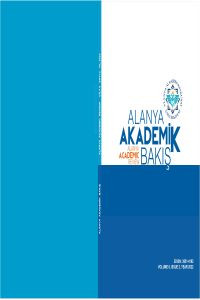Effect of Product Color Lightness on Hedonic Food Consumption The Regulatory Role of Hedonic and Extrinsic Value
Abstract
Food colorants mean to evoke positive feelings about the product on consumers and to increase the pleasure of consumption. Much of the research on packaging and food coloring has been carried out on the effects of certain hues and color categories. The neglected subject of product color lightness and saturation necessitated this research. In the study conducted on hedonic foods, which is the product group in which food colorants are most used, the effect of product color lightness on hedonic consumption, extrinsic value behavior, which is characterized as the tendency to consume snacks, and the regulatory role of hedonic value perception factors, which are defined as the hedonic benefit provided to consumers were examined.
References
- Referans1: AKGUL, D. (2014). Hedonik (Hazcı) Tüketimin Özel Günlerdeki Alışveriş Kültürü Üzerindeki Etkisi Ve Ülkelerarası Karşılaştırmalı Bir Araştırma, Erciyes University, Phd Thesis.
- Referans2: AMIN, L., AZAD, M. A. K. & SAMIAN, A. L. (2013). Factor influencing risk perception of food additives. Journal of Food, Agriculture & Environment, 11(2), 66-72.
- Referans3: AVENA, N. (2015). Hedonic Eating: How the Pleasure of Food Affects Our Brains and Behavior, 1st Edition, Oxford University Press.
- Referans4: BATRA, R. & AHTOLA, O. T. (1991). Measuring the hedonic and utilitarian sources of consumer attitudes. Marketing Letters, 2(2), 159-170.
- Referans5: BEARTH, A. (2014). Risk Perception and Communication of Two Potential Food Risks: Campylobacter and Selected Food Additives, Doctoral Thesis, https://www.research-collection.ethz.ch/handle/20.500.11850/95721, (Erişim Tarihi:18.02.2022).
- Referans6:BURTON, P., SMITH, H. & LIGHTOWLER, H. J. (2007). The influence of restrained and external eating patterns on overeating. Appetite, 49, 191-197.
- Referans7 : COOLS, J., SCHOTTE, D. E. & MCNALLY, R. J. (1992). Emotional arousal and overeating in restrained eaters. Journal of Abnormal Psychology. 101, 348-351.
- Referans8: DELGADO-VARGAS, F. & PAREDES-LOPEZ, O. (2003). Natural colorants for food and nutraceutical uses. Trends in Food Science & Technology, 14, 438.
- Referans9: DHAR, R. & WERTENBROCH, K. (2000). Consumer choice between hedonic and utilitarian goods. Journal of Marketing Research, 37(1), 60-71.
- Referans10: EDWARDS, A. L. (1957). Techniques of Attitude Scale Construction. New York: Appleton-Century-Crofts.
- Referans11: ELLIOT, A. J. & MAIER, M. A. (2007), Color and psychological functioning. Current Directions in Psychological Science, 16(5), 250-254.
- Referans12: EROĞLU, E. İ. & AYAZ, A. (2018). Gıda Katkı Maddelerinin Sağlık Üzerine Etkileri: Risk Değerlendirme. Beslenme ve Diyetetik Dergisi, 46(3), 311-319.
Effect of Product Color Lightness on Hedonic Food Consumption: The Regulatory Role of Hedonic and Extrinsic Value
Abstract
Food colorants mean to evoke positive feelings about the product on consumers and to increase the pleasure of consumption. Much of the research on packaging and food coloring has been carried out on the effects of certain hues and color categories. The neglected subject of product color lightness and saturation necessitated this research. In the study conducted on hedonic foods, which is the product group in which food colorants are most used, the effect of product color lightness on hedonic consumption, extrinsic value behavior, which is characterized as the tendency to consume snacks, and the regulatory role of hedonic value perception factors, which are defined as the hedonic benefit provided to consumers were examined.
References
- Referans1: AKGUL, D. (2014). Hedonik (Hazcı) Tüketimin Özel Günlerdeki Alışveriş Kültürü Üzerindeki Etkisi Ve Ülkelerarası Karşılaştırmalı Bir Araştırma, Erciyes University, Phd Thesis.
- Referans2: AMIN, L., AZAD, M. A. K. & SAMIAN, A. L. (2013). Factor influencing risk perception of food additives. Journal of Food, Agriculture & Environment, 11(2), 66-72.
- Referans3: AVENA, N. (2015). Hedonic Eating: How the Pleasure of Food Affects Our Brains and Behavior, 1st Edition, Oxford University Press.
- Referans4: BATRA, R. & AHTOLA, O. T. (1991). Measuring the hedonic and utilitarian sources of consumer attitudes. Marketing Letters, 2(2), 159-170.
- Referans5: BEARTH, A. (2014). Risk Perception and Communication of Two Potential Food Risks: Campylobacter and Selected Food Additives, Doctoral Thesis, https://www.research-collection.ethz.ch/handle/20.500.11850/95721, (Erişim Tarihi:18.02.2022).
- Referans6:BURTON, P., SMITH, H. & LIGHTOWLER, H. J. (2007). The influence of restrained and external eating patterns on overeating. Appetite, 49, 191-197.
- Referans7 : COOLS, J., SCHOTTE, D. E. & MCNALLY, R. J. (1992). Emotional arousal and overeating in restrained eaters. Journal of Abnormal Psychology. 101, 348-351.
- Referans8: DELGADO-VARGAS, F. & PAREDES-LOPEZ, O. (2003). Natural colorants for food and nutraceutical uses. Trends in Food Science & Technology, 14, 438.
- Referans9: DHAR, R. & WERTENBROCH, K. (2000). Consumer choice between hedonic and utilitarian goods. Journal of Marketing Research, 37(1), 60-71.
- Referans10: EDWARDS, A. L. (1957). Techniques of Attitude Scale Construction. New York: Appleton-Century-Crofts.
- Referans11: ELLIOT, A. J. & MAIER, M. A. (2007), Color and psychological functioning. Current Directions in Psychological Science, 16(5), 250-254.
- Referans12: EROĞLU, E. İ. & AYAZ, A. (2018). Gıda Katkı Maddelerinin Sağlık Üzerine Etkileri: Risk Değerlendirme. Beslenme ve Diyetetik Dergisi, 46(3), 311-319.
Details
| Primary Language | English |
|---|---|
| Subjects | Finance |
| Journal Section | Makaleler |
| Authors | |
| Publication Date | May 31, 2022 |
| Acceptance Date | May 27, 2022 |
| Published in Issue | Year 2022 Volume: 6 Issue: 2 |


